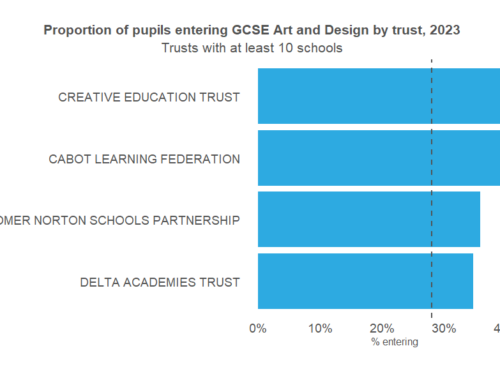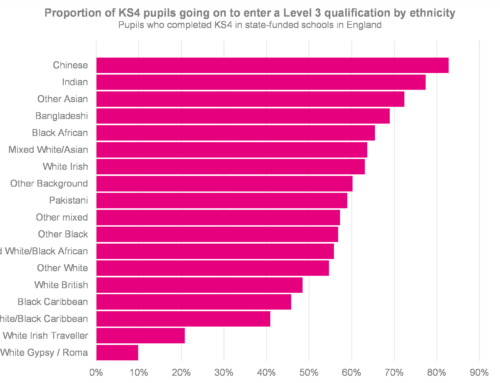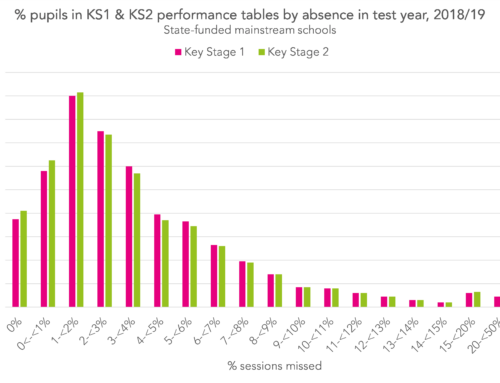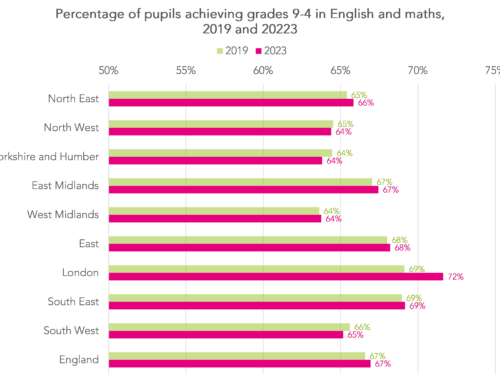Bar a small number of ancient and modern foreign languages, for which results will be reported for the first time next year, the period of GCSE reform in England has now come to an end.
So how does attainment for 16-year-olds in England look, and how has it changed compared to last year?
Differences between subjects
The charts below show the percentages of pupils achieving grade 7/A or above and grade 4/C or above in 2018 and 2019. (Note that a different scale has been used for the two charts, to make it easier to see the detail in each chart.)
Some subjects, such as design and technology, food preparation, music, media studies and PE have seen attainment increase although entries have decreased. We might suppose that lower attaining pupils have switched to other subjects and to alternative non-GCSE qualifications.
FFT Aspire
Schools that subscribe to FFT Aspire can use the free Key Stage 4 Early Results Service, which provides an early analysis of their results. Click here for more information.
Not an FFT Aspire user?
Grade 7 attainment in the single sciences has increased, particularly in physics. There has been only a slight increase in entry in these subjects (0.8%) from 2018 to 2019, despite a larger increase in the 16-year-old population. By contrast, entries in double science have increased by 5.1%. The rise in grade 7 attainment in the triple sciences may well be explained by a smaller share of pupils with lower prior attainment taking the three sciences this year.
Entries in history increased by 7% this year, with the percentage of grade 7 awards unchanged and a slight dip in grade 4 attainment. There was a smaller increase in geography entry (3.8%) and slight increases in attainment at both grade 7 and grade 4.
Similarly in MFL, entries increased in French and Spanish but fell in German. Yet attainment improved in German but either remained the same or fell slightly in French and Spanish.
How attainment can change from year to year
The approach taking by England’s exam regulator, Ofqual, to maintaining grade standards from year to year based on statistical predictions, known as comparable outcomes, ensures that grades awarded don’t change too much from year to year.
Even with comparable outcomes, attainment at the subject level can change from year to year.
This can happen if the prior attainment profile of a subject changes. For example, a larger proportion of pupils from the lower end of the prior attainment distribution entering a subject.
Moreover, senior examiners can deviate from the statistical predictions if they believe there is good evidence of a change in quality of scripts. We do not yet know the extent to which this occurred, or in which subjects, although we do know that Ofqual accepted the judgment of the senior examiners in such cases.
The statistical predictions used in comparable outcomes are also only based on 16-year-olds in non-selective state schools. So if more pupils from the independent sector enter a GCSE, perhaps switching from international GCSE, attainment could well improve.
Finally, evidence from the national reference test was considered in the awarding of English language and maths grades for the first time this year. According to details published today by Ofqual, the national reference test suggested that attainment in English has generally declined since 2017 but gone up in maths. Whereas the improvement in maths fits with the expectation that results will improve in the first few years of a new specification, the decline in English is written off as statistical noise and sampled pupils not being motivated to do well on the NRT. Either way, the results were not used to adjust the grading standard.
The upshot of all of this is that, looking across all GCSE subjects, there was a slight increase in attainment at grade 7 or above (grade A or above in old money) from 21.4% to 21.9%. At grade 4 or above (grade C or above), attainment also increased from 69.2% to 69.9%.
We’ll be back with more detailed analysis of this year’s results shortly, but do take a look now at this year’s results data on our microsite, which allows you to explore trends in GCSE entries and attainment in every subject.
And sign up to our mailing list to be notified about the rest of the analysis that we’ll be publishing today.






Thanks for description of comparable outcomes. Very helpful.